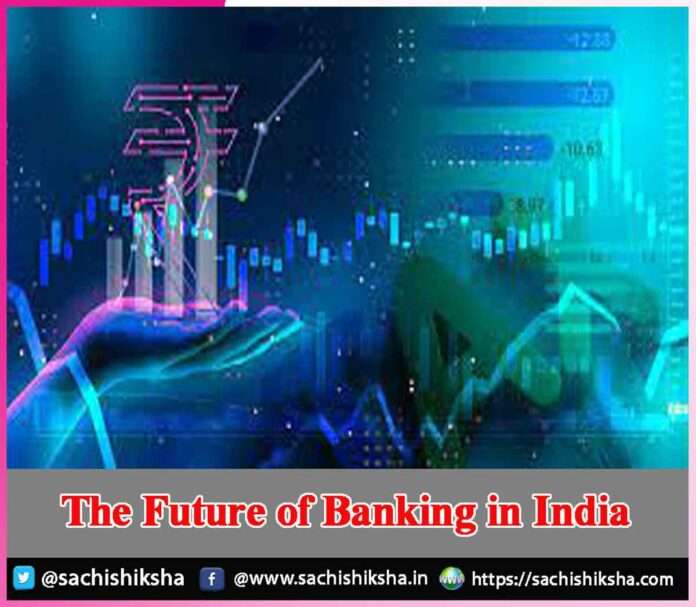The Future of Banking in India
Introduction: The financial services industry in India has had a volatile past, with difficulties and success on the road to long-term growth. The period of strict regulations was followed by progressive liberalization and improvements, resulting in the sector’s fast multiplication.
Commercial financial institutions have reached fresh milestones in response to the economic system’s expansion and demands. Throughout the years, the banking authority has fulfilled its duty carefully, creating an environment that allows for the advancement of the financial system across each industry while demonstrating an effective approach to monetary policy.
As the economy evolved and varied, the strategy taken in financial risk administration and assessment mechanisms changed throughout time. The rising prospects of cutting-edge innovations like as machine learning, artificial intelligence, and cryptocurrency acted as the “new game changer.”
Table of Contents
Achievements & Weaknesses of the Indian Financial System:

These include a decline in structure efficiency and productivity, a deterioration of system revenue, targeted borrowing that played a crucial part in troubling revenues, and focused investments. Income producing capabilities and possibilities were hampered, portfolio reliability decreased as a result of political and administrative interference in credit making choices, and cost structure increased as a result of technology disadvantage.
Upcoming Banking Business Developments in India
Digital Banking Progress:
In India’s economic surroundings, digital banking is establishing itself as a major player. The widespread accessibility of smart phones and low-cost broadband connections has cleared the ground for a digital revolution in the financial services sector. Consumers can now access an extensive selection of financial services, such as handling accounts, settlements, payments, and expenditures, via mobile banking apps and web-based services. As knowledge of technology and accessibility improves the vast majority of financial transactions will be handled digitally, changing the way Indians engage with their institutions.
Data Analysis and Artificial Intelligence:
Data analytics and Artificial Intelligence are revolutionizing the banking business, allowing banks to provide personalized services, improved identification of fraudulent activity, and increase operational effectiveness. Chatbots driven by AI deliver continuous assistance to customers, answering questions and helping with payments. Banks may use sophisticated analytics to get significant information from client data, allowing them to personalize services and goods according to different needs. Furthermore, artificial intelligence algorithms assist in credit risk assessment, resulting in quicker and more reliable approvals of loans.
Block Chain Development and Crypto Currencies:
Block chain technology, which underpins crypto currencies such as Bit coin, has the ability to transform a wide range of financial processes, including payment processing across borders, trade financing, and verification of identity. The decentralized and secure characteristics of block chain can help to improve procedures, save costs. Whereas the Reserve Bank of India (RBI) has raised worries about crypto currencies, it has additionally acknowledged the promise of block chain technology, implying that a controlled digital currency may be developed in the years to come.
Partnership and Transparency in Banking:
In India, public banking has begun. It enables third-party developers to create services and applications based on the information and architecture of banks, providing customers with a larger selection of financial alternatives. An open financial service fosters creative thinking and rivalry by encouraging collaboration among conventional financial institutions, new fintech companies, and other technology suppliers. Consumers will have the opportunity to utilize a broader range of personalized goods and services as additional companies enter the market, increasing the financial expertise.
Regional Banking and Financial Participation:
With the advent of the Jan Dhan Yojana and Aadhaar (unique identification) connection, India has made tremendous progress in financial inclusion. However, there is a sizable unexplored consumer market in remote regions. The next generation of banking in India depends upon technological advances to reach the underprivileged and unbanked communities. Mobile banking and electronic payment methods can help overcome the divide, allowing individuals living in rural locations to gain access to banking services, safeguard money, and establish credit.
Improved Customer Experience:
The future of banking in India is focused on improving the client engagement. To provide effortless, personalized, and easy financial services, banks are making investments in innovative electronic channels such as banking apps for mobile devices and online financial systems. Customers can now do multiple things from the convenience of their own residences, such as transferring money, payment of bills, and applications for loans. The incorporation of chatbots with artificial intelligence and automated assistants allows for 24-hour customer care, responding questions and addressing difficulties in immediate response.
Partnership in the Financial Technology Sector:
The growth of fintech firms in India has upended conventional financial standards, paving the possibility for partnerships among banks and technology companies. This relationship allows banks to use technological advances like peer-to-peer borrowing, robo-advisory services, and electronic wallets to improve their line of products and attract a wider range of customers. Fintech firms offer responsiveness, creativity, and consumer-centric remedies, while banks offer regulatory knowledge, facilities and consumer trust. This collaboration between banks and fintech firms has tremendous potential for increasing financial inclusion and increasing access to banking services in remote places.
Blockchain Computing for Verified Transactions:
By enabling safe and transparent transactions, block chain technology has an opportunity to change the Indian banking system. Implementing block chain can help simplify procedures like payments across borders, financing of supply chains, and verification of identity. The smart contract technology provided by block chain may streamline and certify numerous financial arrangements, eliminating the demand for intermediates and lowering the cost of transactions. Banks may use block chain to enhance safety, minimize deception, and enhance settlement of transactions productivity, eventually benefiting both the banks and their consumers.
Increasing Horizon:
The Indian banking system has made great strides, with organizations such as the State Bank of India ranked 49th among the world’s top 50 banks. However, as the market expands, considerable expenditures are required to maintain this expansion. Banks should concentrate on improving the way they operate and creating efficient mechanisms for risk management in order to fulfill the needs of an economic boom.
Rise of Payment Institutions:
The rise of payment institutions in India brought about fresh possibilities. Considering their streamlined account opening processes and emphasis on offering basic financial services, these financial institutions have the potential to reach under banked and unbanked parts of the general population. Their agile operations and digital-first attitude hint at the future of banking.
Furthermore, specialized banks, such as AU Small Finance Banks, have grown in popularity, serving to certain industries such as agriculture. Banks may accommodate farmers’ requirements and help to the expansion of the agricultural industry by delivering specific plans and financial solutions.
Fresh Obstacles:
However, the expanding influence of technology brings with it fresh obstacles. Cybercrime has grown into a major threat for banks, requiring stringent cyber security safeguards. Banks have to prioritize investments in security measures as the sector evolves to safeguard client data, combat fraud, and preserve trust in the online environment.
Conclusion:
The Indian banking system has seen a tremendous shift, promoting financial accessibility, propelling growth in the economy, and adopting technology advances. As the government aims for increased levels of financial empowerment and global competitiveness, the industry must focus on ongoing creativity, upgrades to infrastructure, and measures for cyber security. By accepting possibilities and exploiting new technologies, the Indian banking sector can strengthen its status as a foundation of the nation’s economic growth, allowing development and economical security for all individuals.













































